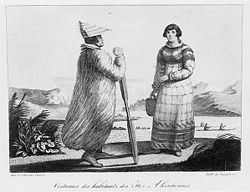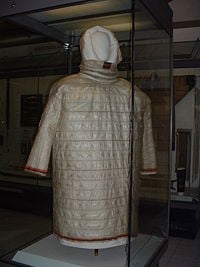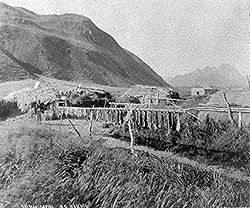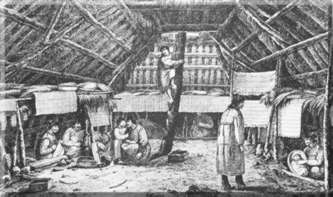Difference between revisions of "Aleut" - New World Encyclopedia
m (→References) |
m |
||
| Line 19: | Line 19: | ||
The '''Aleuts''' ('''Unangax''', '''Unangan''' or '''Unanga''') are the indigenous people of the [[Aleutian Islands]] of [[Alaska]], [[United States]] and Kamchatka Oblast, [[Russia]]. They are related to the [[Inuit]] and [[Yupik]] people. The homeland of the Aleuts includes the Aleutian Islands, the [[Pribilof Islands]], the [[Shumagin Islands]], and the far western part of the Alaskan Peninsula. | The '''Aleuts''' ('''Unangax''', '''Unangan''' or '''Unanga''') are the indigenous people of the [[Aleutian Islands]] of [[Alaska]], [[United States]] and Kamchatka Oblast, [[Russia]]. They are related to the [[Inuit]] and [[Yupik]] people. The homeland of the Aleuts includes the Aleutian Islands, the [[Pribilof Islands]], the [[Shumagin Islands]], and the far western part of the Alaskan Peninsula. | ||
| − | + | They were skilled at [[hunting]] and [[fishing]] in this harsh climate, skills that were bitterly exploited by [[Russia]]n [[fur]] traders after their arrival around 1750. They received assistance and support from the [[Russian Orthodox]] missionaries subsequently and became closely aligned with Orthodox practices and beliefs. Despite this, an estimated 90 percent of the population was killed during the years of Russian fur trade. During the nineteenth century the Aleuts were deported from the Aleutian Islands to the Komandorski Islands (now part of Kamchatka Oblast) by a Russian-American company. They were transferred to American citizenship late in the twentieth century after Alaska was purchased by the United States from Russia. The tribe has made a recovery, and their wisdom and perseverance are qualities that allow them to work with others in the process of building a world of peace. | |
| + | |||
| + | ==Name== | ||
| + | The '''Aleut''' (pronounced al-ee-oot) people were so named by [[Russia]]n [[fur]] traders during the Russian fur trade period in the eighteenth and nineteenth centuries. Their original name was ''Unangan'', a word associated with “coastline.” The first migration of the ancestral line from [[Asia]] is believed to be 12,000 to 15,000 years ago. | ||
==History== | ==History== | ||
| − | + | The Aleut trace permanent settlement to about 8,000 years ago in the Aleutian archipelago that stretches over 1,300 miles between [[Alaska]] and [[Siberia]]. [[Anthropology|Anthropologist]]s are not certain of their exact origins (Siberia or Subarctic) but most believe they arrived later than the more southern tribes (around 4,000 years ago). Two [[culture]]s developed: the Kodiak (circa 2,500 B.C.E.) and Aleutian (circa 2,000 B.C.E.).<ref>Barry Pritzker, ''A Native American Encyclopedia'' (New York, NY: Oxford University Press, 2000, ISBN 0195138775).</ref> | |
| − | |||
| − | |||
[[Image%3A1860-russian-america.jpg|left|thumb]] | [[Image%3A1860-russian-america.jpg|left|thumb]] | ||
| − | + | The Aleuts' skill at [[hunting]] and surviving in the hard environment made them valuable and later exploited by Russian fur traders after their arrival in 1750.<ref name=corbett>Helen D. Corbett and Susanne M. Swibold, [http://www.amiq.org/aleuts.html The Aleuts of the Pribilof Islands, Alaska] Retrieved November 3, 2011. Reproduced with permission from Milton M.R. Freeman (ed.), ''Endangered people of the Arctic: Struggles to Survive and Thrive'' (Westport, CT: Greenwood Press, 2000, ISBN 978-0313306495). </ref> [[Russian Orthodox]] missionaries referred to the austere environment as “the place that God forgot.” <ref>Michael Oleksa, ''Alaskan Missionary Spirituality,'' (New York, NY: Paulist Press, 1987, ISBN 0809103869).</ref> | |
| − | |||
| − | + | Within fifty years after Russian contact, the population of the Aleut was 12,000 to 15,000 people. At the end of the twentieth century, it was 2,000.<ref>Margaret Lantis, ''Handbook of North American Indians Volume 5 Arctic'' David Damas (ed.) (Washington DC: Smithsonian Institute Press, 1984, ISBN 0874741858), 163.</ref> Clearly, exposure of the Aleut people to Russian encroachment had a very detrimental outcome on the survival rate of subsequent generations. There was, however, a counterbalancing force that came from the missionary work of the [[Russian Orthodox Church]]. The priests, who were educated men, took great interest in preserving the language and lifestyle of the indigenous people of Alaska. One of the earliest [[Christianity|Christian]] [[martyr]]s in [[North America]] was Saint Peter the Aleut. | |
[[Image:Aleut village.jpg|thumb|right|250 px|Salmon drying. Aleut village, Old Harbor, Alaska. Photographed by N. B. Miller, 1889]] | [[Image:Aleut village.jpg|thumb|right|250 px|Salmon drying. Aleut village, Old Harbor, Alaska. Photographed by N. B. Miller, 1889]] | ||
| Line 42: | Line 42: | ||
===Language=== | ===Language=== | ||
The [[Aleut language]] is in the [[Eskimo-Aleut languages]] family. It is related to the [[Inuit language|Inuit]] and [[Yupik language|Yupik]] languages spoken by the [[Eskimo]]. It has no known wider affiliation, but supporters of the [[Nostratic]] hypothesis sometimes include it as Nostratic. | The [[Aleut language]] is in the [[Eskimo-Aleut languages]] family. It is related to the [[Inuit language|Inuit]] and [[Yupik language|Yupik]] languages spoken by the [[Eskimo]]. It has no known wider affiliation, but supporters of the [[Nostratic]] hypothesis sometimes include it as Nostratic. | ||
| + | [[ | ||
| + | Ivan Veniaminov]] began to develop a [[writing]] system in 1824 for the Aleut language so that [[education]]al and [[religion|religious]] materials could be translated. Continuous work has taken place through the work of dedicated linguists through the twentieth century. [[Knut Bergsland]] from 1950 until his death in 1998 worked with Aleut speakers and produced a comprehensive Aleut [[dictionary]] in 1994, and in 1997 a detailed reference [[grammar]] book.<ref> Aleutian Pribilof Island Community Development Association, [http://www.apicda.com/aleut_culture.html Aleut Culture] Retrieved November 3, 2011.</ref> | ||
===Social structure=== | ===Social structure=== | ||
| Line 49: | Line 51: | ||
===Religion=== | ===Religion=== | ||
[[Image:Parka (Kamleika) Aleutian Islands.JPG|thumb|left|200 px|Parka (Kamleika) Aleutian Islands. Aleut hood ceremonial kamleika. Waterproof overdress of sea mammal gut. Panel at chin is dyed gut applique with red wool embroidery. Fur and dyed gut applique trim the cuffs and hem. Human hair decorates the seams. Worn by a person of high rank or by a shaman when making contact wth the spirit world.]] | [[Image:Parka (Kamleika) Aleutian Islands.JPG|thumb|left|200 px|Parka (Kamleika) Aleutian Islands. Aleut hood ceremonial kamleika. Waterproof overdress of sea mammal gut. Panel at chin is dyed gut applique with red wool embroidery. Fur and dyed gut applique trim the cuffs and hem. Human hair decorates the seams. Worn by a person of high rank or by a shaman when making contact wth the spirit world.]] | ||
| − | + | Aleut men honored creatures of the sea and honored them through the ornamentation on their [[hunting]] costumes. Hunting was the lifeline of the Aleut people. Animals, fish, and birds were revered and considered to have [[soul]]s. [[Ritual]]s were sometimes performed to release the hunted animal's soul. Newborn babies were named after someone who had died in order that the deceased person could live on in the child. There was also a belief in the soul going to a land in the sea or sky. Wooden [[mask]]s of animals were often used in ritual dances and story telling. | |
| − | |||
[[Shaman]]s were very important. They were able to go into a trance and receive messages from [[spirit]]s to help with the hunting or with healing. They also could perform evil actions against others. Important deities were Sea Woman (Sedna) in charge of sea animals, Aningaaq in charge of the sun, and Sila in charge of the air. | [[Shaman]]s were very important. They were able to go into a trance and receive messages from [[spirit]]s to help with the hunting or with healing. They also could perform evil actions against others. Important deities were Sea Woman (Sedna) in charge of sea animals, Aningaaq in charge of the sun, and Sila in charge of the air. | ||
| Line 64: | Line 65: | ||
==Notes== | ==Notes== | ||
| − | < | + | <references/> |
==References== | ==References== | ||
Revision as of 22:47, 3 November 2011
| Aleut | ||||||
|---|---|---|---|---|---|---|
 Traditional Aleut dress | ||||||
| Total population | ||||||
| 17,000 to 18,000 | ||||||
| Regions with significant populations | ||||||
| ||||||
| Languages | ||||||
| English, Russian, Aleut | ||||||
| Religions | ||||||
| Christianity, Shamanism | ||||||
| Related ethnic groups | ||||||
| Inuit, Yupiks |
The Aleuts (Unangax, Unangan or Unanga) are the indigenous people of the Aleutian Islands of Alaska, United States and Kamchatka Oblast, Russia. They are related to the Inuit and Yupik people. The homeland of the Aleuts includes the Aleutian Islands, the Pribilof Islands, the Shumagin Islands, and the far western part of the Alaskan Peninsula.
They were skilled at hunting and fishing in this harsh climate, skills that were bitterly exploited by Russian fur traders after their arrival around 1750. They received assistance and support from the Russian Orthodox missionaries subsequently and became closely aligned with Orthodox practices and beliefs. Despite this, an estimated 90 percent of the population was killed during the years of Russian fur trade. During the nineteenth century the Aleuts were deported from the Aleutian Islands to the Komandorski Islands (now part of Kamchatka Oblast) by a Russian-American company. They were transferred to American citizenship late in the twentieth century after Alaska was purchased by the United States from Russia. The tribe has made a recovery, and their wisdom and perseverance are qualities that allow them to work with others in the process of building a world of peace.
Name
The Aleut (pronounced al-ee-oot) people were so named by Russian fur traders during the Russian fur trade period in the eighteenth and nineteenth centuries. Their original name was Unangan, a word associated with “coastline.” The first migration of the ancestral line from Asia is believed to be 12,000 to 15,000 years ago.
History
The Aleut trace permanent settlement to about 8,000 years ago in the Aleutian archipelago that stretches over 1,300 miles between Alaska and Siberia. Anthropologists are not certain of their exact origins (Siberia or Subarctic) but most believe they arrived later than the more southern tribes (around 4,000 years ago). Two cultures developed: the Kodiak (circa 2,500 B.C.E.) and Aleutian (circa 2,000 B.C.E.).[1]
The Aleuts' skill at hunting and surviving in the hard environment made them valuable and later exploited by Russian fur traders after their arrival in 1750.[2] Russian Orthodox missionaries referred to the austere environment as “the place that God forgot.” [3]
Within fifty years after Russian contact, the population of the Aleut was 12,000 to 15,000 people. At the end of the twentieth century, it was 2,000.[4] Clearly, exposure of the Aleut people to Russian encroachment had a very detrimental outcome on the survival rate of subsequent generations. There was, however, a counterbalancing force that came from the missionary work of the Russian Orthodox Church. The priests, who were educated men, took great interest in preserving the language and lifestyle of the indigenous people of Alaska. One of the earliest Christian martyrs in North America was Saint Peter the Aleut.
Fur trade first annihilated the sea otter and then focused on the massive exploitation of fur seals. Aleutian men were transported to areas where they were needed on a seasonal basis. The Pribilof Islands (named for Russian navigator Gavriil Pribilof’s discovery in 1786) became the primary place where seals were harvested en masse. The Aleuts faired well during this period as Russian citizens but rapidly lost status after the American purchase of Alaska in 1867. The seal industry was viewed by the U.S. Treasury as a windfall for revenue gathering. Aleuts lost their rights, endured injustices and finally were reduced to a state of servitude when evacuated and interned in old fish canneries until the end of World War II.
In 1942, Japanese forces occupied Attu and Kiska Islands in the western Aleutians, and later transported captive Attu Islanders to Hokkaidō, where they were held as POWs. Hundreds more Aleuts from the western chain and the Pribilofs were evacuated by the United States government during World War II and placed in internment camps in southeast Alaska, where many died. It was not until the mid-1960s that the Aleut were given American citizenship. In 1983, the U.S. government eliminated all financial allocations to the inhabitants of the Pribilofs. A trust fund of 20 million dollars was approved by Congress to initiate alternative sources of income such as fishing. This proved very successful as the Pribilofs became a primary point for international fishing vessels and processing plants. The Aleut Restitution Act of 1988 was an attempt by Congress to compensate survivors of the internment camps. By the late 1990s, the impact of environmental changes began to cast shadows over the economy of the North Sea region.
Culture
Aleuts constructed "barabaras" — partially underground houses. According to Lillie McGarvey, a twentieth-century Aleut leader, barabaras have the properties of "keeping occupants dry from the frequent rains, warm at all times, and snugly sheltered from the high winds common to the area."
Language
The Aleut language is in the Eskimo-Aleut languages family. It is related to the Inuit and Yupik languages spoken by the Eskimo. It has no known wider affiliation, but supporters of the Nostratic hypothesis sometimes include it as Nostratic. [[ Ivan Veniaminov]] began to develop a writing system in 1824 for the Aleut language so that educational and religious materials could be translated. Continuous work has taken place through the work of dedicated linguists through the twentieth century. Knut Bergsland from 1950 until his death in 1998 worked with Aleut speakers and produced a comprehensive Aleut dictionary in 1994, and in 1997 a detailed reference grammar book.[5]
Social structure
Prior to Russian contact, Aleut society was a ranked system of heredity classes. There were positions similar to nobles, commoners, and slaves in the Western world. The highest ranking were given special places in the long house as well as burial sites. The east was important as the place where the Creator, Agugux, resided, thus the best place to be located. [6]
Religion

Aleut men honored creatures of the sea and honored them through the ornamentation on their hunting costumes. Hunting was the lifeline of the Aleut people. Animals, fish, and birds were revered and considered to have souls. Rituals were sometimes performed to release the hunted animal's soul. Newborn babies were named after someone who had died in order that the deceased person could live on in the child. There was also a belief in the soul going to a land in the sea or sky. Wooden masks of animals were often used in ritual dances and story telling.
Shamans were very important. They were able to go into a trance and receive messages from spirits to help with the hunting or with healing. They also could perform evil actions against others. Important deities were Sea Woman (Sedna) in charge of sea animals, Aningaaq in charge of the sun, and Sila in charge of the air.
Arts
Weapon-making, building of baidarkas (special hunting boats), and weaving are some of the traditional arts of the Aleuts. Nineteenth-century craftsmen were famed for their ornate wooden hunting hats, which feature elaborate and colorful designs and may be trimmed with sea lion whiskers, feathers, and ivory. Aleut seamstresses created finely stitched waterproof parkas from seal gut, and some women still master the skill of weaving fine baskets from rye and beach grass. Aleut men wore wooden hunting hats. The length of the visor indicated rank.
Aleut basketry is some of the finest in the world, the continuum of a craft dating back to prehistoric times and carried through to the present. Early Aleut women created baskets and woven mats of exceptional technical quality using only an elongated and sharpened thumbnail as tool. Today Aleut weavers continue to produce woven pieces of a remarkable cloth-like texture, works of modern art with roots in ancient tradition. The Aleut word for grass basket is qiigam aygaaxsii.
Contemporary Issues
Following a devastating oil spill in 1996, the Aleut could not deny that life was again changing for them and future generations. A revival of interest in Aleut culture has subsequently been initiated as leaders rally the Aleut youth to understand their historic relationship with the environment and to seek opportunities to work on behalf of the environment into the future. In 1998, Aleut leader, Aquilina Bourdukofsky wrote: “I believe we exist generationally. Would we be as strong as we are if we didn’t go through the hardships, the slavery? It’s powerful to hear the strength of our people – that’s what held them together in the past and today.”[2]
Notes
- ↑ Barry Pritzker, A Native American Encyclopedia (New York, NY: Oxford University Press, 2000, ISBN 0195138775).
- ↑ 2.0 2.1 Helen D. Corbett and Susanne M. Swibold, The Aleuts of the Pribilof Islands, Alaska Retrieved November 3, 2011. Reproduced with permission from Milton M.R. Freeman (ed.), Endangered people of the Arctic: Struggles to Survive and Thrive (Westport, CT: Greenwood Press, 2000, ISBN 978-0313306495).
- ↑ Michael Oleksa, Alaskan Missionary Spirituality, (New York, NY: Paulist Press, 1987, ISBN 0809103869).
- ↑ Margaret Lantis, Handbook of North American Indians Volume 5 Arctic David Damas (ed.) (Washington DC: Smithsonian Institute Press, 1984, ISBN 0874741858), 163.
- ↑ Aleutian Pribilof Island Community Development Association, Aleut Culture Retrieved November 3, 2011.
- ↑ Lydia T. Black and R. G. Liapunova, North Pacific, Sub- and Neo-Arctic Shamanism: Peoples of Alaska Retrieved November 3, 2011.
ReferencesISBN links support NWE through referral fees
- Bergsland, Knut. Aleut Dictionary: Unangam Tundguaii. Fairbanks, AK: Alaska Native Language Center, 1994. ISBN 978-1555000479
- Bergsland, Knut. Aleut Grammar: Unangam Tunuganaan Achixaasix. Fairbanks, AK: Alaska Native Language Center, 1997. ISBN 978-1555000646
- Damas, David (ed.). Handbook of North American Indians Volume 5 Arctic. Washington DC: Smithsonian Institute Press, 1984. ISBN 0874741858
- Freeman, Milton M.R. (ed.). Endangered people of the Arctic: Struggles to Survive and Thrive. Westport, CT: Greenwood Press, 2000. ISBN 978-0313306495
- Lantis, Margaret. Ethnohistory in Southwestern Alaska and the Southern Yukon. Lexington, KY: University of Kentucky Press, 1970. ISBN 081311215X
- Oleksa, Michael. Alaskan Missionary Spirituality. New York, NY: Paulist Press. 1987. ISBN 0809103869
- Pritzker, Barry. A Native American Encyclopedia New York, NY: Oxford University Press, 2000. ISBN 0195138775
External links
All links retrieved November 3, 2011.
- The AMIQ Institute - a research project documenting the Pribilof Islands and their inhabitants.
- The Aleut Foundation
- Aleutian Pribilof Islands Association
- Qawalangin Tribe of Unalaska
- Museum of the Aleutians
- Aleutian Pribilof Island Community Development Association
Credits
New World Encyclopedia writers and editors rewrote and completed the Wikipedia article in accordance with New World Encyclopedia standards. This article abides by terms of the Creative Commons CC-by-sa 3.0 License (CC-by-sa), which may be used and disseminated with proper attribution. Credit is due under the terms of this license that can reference both the New World Encyclopedia contributors and the selfless volunteer contributors of the Wikimedia Foundation. To cite this article click here for a list of acceptable citing formats.The history of earlier contributions by wikipedians is accessible to researchers here:
The history of this article since it was imported to New World Encyclopedia:
Note: Some restrictions may apply to use of individual images which are separately licensed.


